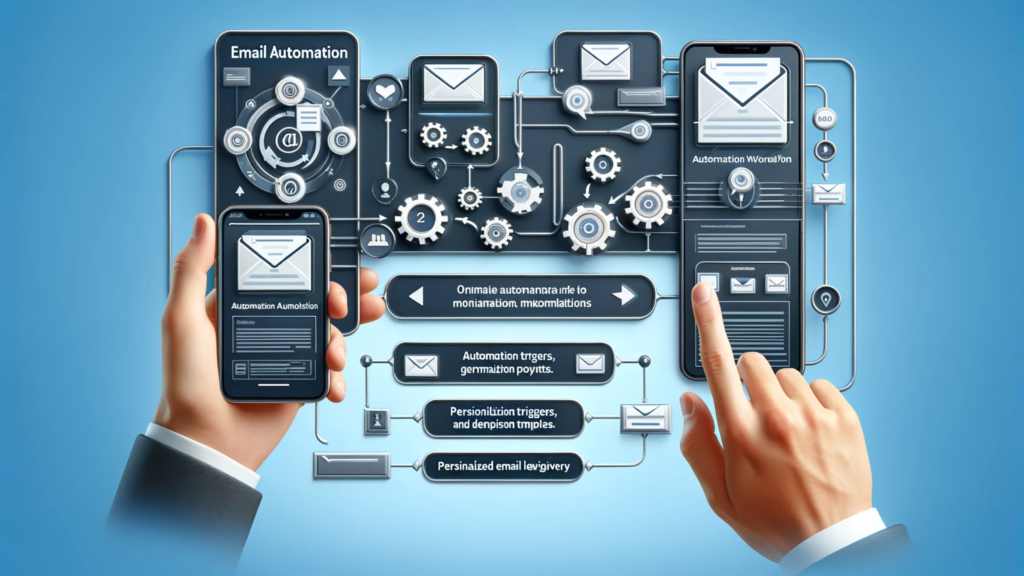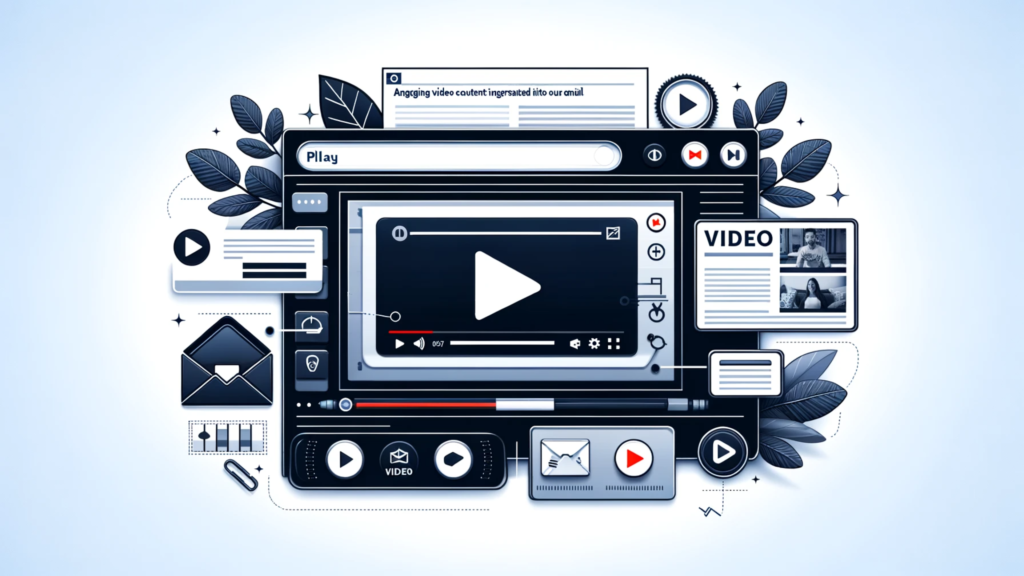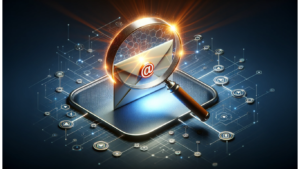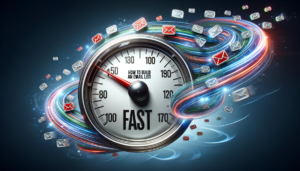In today’s digital landscape, mastering email marketing strategies is more than a competitive edge; it’s a necessity for any business aiming to thrive online.
With the ever-evolving dynamics of digital communication, email marketing offers a unique blend of personalization, reach, and effectiveness. This blog post delves deep into the world of email marketing, uncovering the essential strategies and innovative approaches that can transform your email campaigns from mundane to remarkable.
From the nuances of crafting personalized content to the advanced techniques of list segmentation and the integration of cutting-edge AI and automation, we explore the key elements that make email marketing strategies not just good, but great.
Whether you’re a seasoned marketer or just starting, these insights will equip you with the tools and knowledge to elevate your email marketing game and achieve remarkable success in your digital marketing endeavors.
If you’re new to this domain or looking to refresh your knowledge, start with our Understanding Email Marketing – A Comprehensive Guide for 2024. This guide lays the foundation for effective email marketing strategies, making it a great resource for beginners and seasoned marketers alike.

Table of Contents
Key Takeaways
| Key Takeaway | Description |
|---|---|
| Personalization and Segmentation | Tailor emails to specific audience segments to enhance relevance and engagement. |
| Automation and AI Integration | Utilize automation and AI for efficient, timely, and relevant email interactions. |
| Compliance with Legal Standards | Adhere to CAN-SPAM, GDPR, and other regulations to build trust and ensure ethical practices. |
| Multimedia and Video Content | Incorporate videos and multimedia elements to engage visually and enhance message impact. |
| Continuous Testing and Analytics | Regularly analyze performance and adapt strategies for ongoing effectiveness. |
| Dynamic Strategy Evolution | Stay updated with trends and technologies to keep email marketing strategies fresh and relevant. |
Part 1: Understanding Email Marketing and Its Core Strategies
Introduction to Email Marketing: The Bedrock of Successful Email Marketing Strategies

Email marketing stands as a cornerstone in the digital marketing landscape, and understanding its nuances is crucial for any business looking to thrive online. This method involves sending targeted messages via email to a curated list of recipients, aiming to promote products, share news, or nurture customer relationships.
The Definition of Email Marketing: At its core, email marketing is a strategic tool used for communicating with potential and existing customers. Unlike one-size-fits-all advertising, email marketing allows for personalized, direct interaction with your audience. It’s a way to share tailored messages, from product launches to newsletters, directly to those who have expressed interest in your brand.
Importance in Today’s Digital Ecosystem: In a world where digital presence is non-negotiable, email marketing strategies offer an unparalleled advantage. They help in building strong customer relationships, enhancing brand recognition, and boosting conversions. This form of marketing is known for its high return on investment (ROI), offering businesses a powerful way to reach their audience effectively and economically.
Incorporating the Right Strategies: To leverage the full potential of email marketing, it’s not just about sending emails; it’s about sending the right emails. Effective email marketing strategies encompass a range of tactics from segmentation, personalization, to timing and frequency management. These strategies ensure that your message resonates with your audience, leading to higher engagement and conversion rates.
Internal Linking and Its Role: An often-overlooked aspect of email marketing is the strategic use of internal links. By linking to relevant content on your website, you not only provide additional value to your readers but also drive traffic to your site, improving search engine rankings and visibility.
LSI Keywords Integration: To enhance SEO, it’s essential to incorporate LSI (Latent Semantic Indexing) keywords related to email marketing strategies. Terms such as ’email campaign optimization’, ‘subscriber engagement’, ‘conversion rate’, ’email automation’, and ‘targeted email content’ align closely with the primary keyword and are likely expected by search engines to be present in comprehensive content on this topic.
In conclusion, the essence of email marketing lies in its ability to forge a direct link between businesses and customers. By harnessing the power of personalized communication and integrating effective email marketing strategies, businesses can unlock significant growth opportunities. Stay tuned as we delve deeper into specific email marketing strategies that can transform your digital marketing efforts.
Choosing the Right Email Marketing Platform: A Key Component of Email Marketing Strategies

Selecting an email marketing platform is a pivotal decision in shaping successful email marketing strategies. This choice is not just about sending emails; it’s about finding a tool that complements your marketing goals, audience insights, and content strategies. When it comes to email marketing, the platform you choose can be the difference between a campaign that resonates and one that falls flat.
Firstly, consider what you need in an email marketing platform. Do you require advanced automation features, or is a user-friendly interface more crucial? How important are analytics and reporting to your email marketing strategies? Different platforms offer varying features, from basic email builders to complex, AI-driven campaign tools.
One key aspect to consider is integration. The right platform should seamlessly integrate with your existing tools and systems, like CRM software or e-commerce platforms. This synergy ensures a smoother workflow and more cohesive email marketing strategies.
Personalization capabilities are another vital factor. Modern consumers expect tailored content, and the right platform should offer robust segmentation and personalization features. This goes beyond just addressing subscribers by their first name. Think of dynamic content, behavior-triggered emails, and segmentation based on detailed subscriber data.
Scalability is essential, too. As your business grows, your email marketing strategies will evolve. Choose a platform that can grow with you, offering more advanced features as your subscriber list and marketing needs expand.
Cost is always a consideration, but remember, the cheapest option isn’t always the best for long-term strategy. Evaluate the ROI potential of each platform – sometimes, investing more upfront can lead to greater returns down the line.
For a deeper understanding of email marketing’s fundamentals and its strategic importance, revisit our introductory guide on Email Marketing. Additionally, for a comprehensive overview of email marketing in action, check out HubSpot’s insightful Email Marketing Guide.
In conclusion, choosing the right platform is a critical step in crafting effective email marketing strategies. It’s not just about sending emails – it’s about creating a connection, understanding your audience, and delivering value at every touchpoint.
Crafting Effective Email Campaigns: A Core Aspect of Email Marketing Strategies

Crafting effective email campaigns is at the heart of successful email marketing strategies. It’s about understanding your audience in-depth and tailoring your messages to meet their needs, preferences, and behaviors.
Understanding Your Audience: The First Step in Email Marketing: Before you even begin drafting your email, it’s crucial to understand who you are talking to. This involves diving deep into your audience’s demographics, interests, pain points, and online behavior. Utilizing tools like audience analytics and customer feedback can provide invaluable insights into what your audience values and expects.
Segmentation: Tailoring Your Approach: Once you have a clear understanding of your audience, segmentation becomes key. Dividing your audience into smaller, more specific groups allows for more targeted and personalized email campaigns. This personalization can range from addressing recipients by their first name to customizing content based on their past interactions with your brand.
Creating Relevant and Engaging Content: Your email content should resonate with your audience. This means crafting messages that are not only informative but also engaging and relatable. Utilize a tone that aligns with your brand voice and speaks directly to your audience’s interests and needs. Incorporate storytelling and real-life examples to make your content more compelling.
The Role of Design in Email Campaigns: Design is not just about aesthetics; it’s about functionality and user experience. Ensure your emails are visually appealing and easy to navigate. Responsive design is crucial, as a significant portion of emails are opened on mobile devices. The design should complement your content, making it easy for readers to digest and act upon.
Incorporating LSI Keywords: Including LSI (Latent Semantic Indexing) keywords related to email marketing strategies, such as ‘target audience analysis’, ‘behavioral segmentation’, ‘engagement metrics’, and ‘responsive email design’, will bolster your SEO efforts and signal to search engines the relevancy and depth of your content.
Testing and Optimization: No email campaign is perfect from the get-go. Continuous testing, from A/B testing subject lines to experimenting with send times, helps in refining your approach. Analyzing performance metrics gives you insights into what works and what doesn’t, allowing you to optimize future campaigns for better engagement and conversion rates.
In conclusion, crafting effective email campaigns is a dynamic and vital part of email marketing strategies. It demands a deep understanding of your audience and a willingness to continuously adapt and refine your approach. By focusing on personalization, relevant content, and ongoing optimization, you can create email campaigns that not only capture attention but also drive meaningful results.
Building and Segmenting Email Lists: Vital for Effective Email Marketing Strategies

At the heart of successful email marketing strategies lies the art of building and segmenting email lists. This process is more than just collecting email addresses; it’s about cultivating a community interested in what you have to offer and engaging them with content tailored to their preferences and needs.
The Importance of Opt-ins in Building Email Lists: The foundation of a robust email list is consent. Opt-in methods, such as sign-up forms on your website or during purchases, ensure that the people who join your list are genuinely interested in your brand. This consent-based approach not only aligns with legal standards like GDPR but also enhances the quality of your list, leading to higher engagement rates.
Strategies for Growing Your Email List: Growing your email list requires strategic thinking. Offering incentives like e-books, webinars, or discount codes can encourage sign-ups. Additionally, optimizing your website with strategically placed sign-up forms and leveraging social media channels to promote your newsletter are effective tactics. Remember, the goal is to provide value that entices potential subscribers to willingly share their email addresses.
Segmentation: The Key to Personalization: Once you’ve built your list, segmentation becomes critical. This involves categorizing your subscribers based on criteria such as demographics, purchase history, or engagement levels. Effective segmentation allows you to send more personalized and relevant emails, which are crucial in today’s cluttered inbox environment.
The Role of Segmentation in Email Marketing Strategies: Proper segmentation allows for targeted campaigns that resonate with different groups within your audience. For instance, new subscribers might receive welcome emails, while long-time customers receive loyalty rewards. This tailored approach not only improves engagement but also fosters a deeper connection with your audience.
Incorporating LSI Keywords: To enhance your content’s SEO, including LSI keywords such as ‘subscriber engagement’, ’email list growth tactics’, ‘personalized email content’, and ‘audience targeting strategies’ is essential. These terms are integral to email marketing strategies and help in aligning your content with what search engines expect.
Continuous List Maintenance: An often-overlooked aspect of list management is the need for ongoing maintenance. Regularly cleaning your list by removing inactive subscribers and updating information ensures that your efforts are focused on engaged and interested recipients.
In conclusion, building and segmenting email lists are fundamental aspects of email marketing strategies. By focusing on opt-in methods for list building and implementing effective segmentation, you can create more personalized and impactful email campaigns. This approach not only enhances engagement but also drives better results from your email marketing efforts.
For more insights into building an effective email list, be sure to check out Essential Strategies for Mastering Email List Building in 2024: A Comprehensive Guide . This guide offers detailed strategies that are crucial for developing a robust email list in today’s digital landscape.
Creating Engaging Content: Essential for Thriving Email Marketing Strategies

In the realm of email marketing strategies, the creation of engaging content stands as a pivotal element. It’s the bridge that connects your brand with your audience, transforming simple messages into compelling conversations.
The Art of Email Copywriting: The essence of captivating email content lies in its copywriting. Your words should not only inform but also inspire and persuade. Start with a captivating subject line – your first impression in the inbox. It should spark curiosity or offer value that compels the recipient to open the email. Inside, keep your language clear, concise, and conversational. Personalization goes beyond using the recipient’s name; it’s about crafting a message that resonates with their interests and needs.
Design That Enhances Your Message: The design of your email is as crucial as the words you use. A well-designed email should be visually appealing and reflect your brand’s identity. Use a clean layout, readable fonts, and a color scheme that aligns with your brand. Images and graphics should complement, not overpower, your message. Remember, a significant number of users will view your email on mobile devices, so responsive design is non-negotiable.
Incorporating Visuals and Multimedia: Including visuals like images, infographics, or even short videos can significantly increase engagement. These elements break up the text and make the email more engaging. However, balance is key – too many visuals can distract from your message and increase loading times.
Effective Call-to-Actions (CTAs): Your email should have a clear purpose, often manifested in a call-to-action. Whether it’s to read a blog post, check out a new product, or take advantage of a sale, your CTA should be clear and enticing. Position it prominently and make sure it stands out.
LSI Keywords Integration: Including LSI keywords like ‘engagement boosting techniques’, ’email design best practices’, ‘copywriting for emails’, and ‘responsive email layouts’ within your content can significantly improve its SEO relevance. These terms are intrinsically linked to effective email marketing strategies, signaling to search engines the depth and relevance of your content.
Testing and Feedback: Lastly, the effectiveness of your content isn’t set in stone. Regular testing and adapting based on feedback are crucial. Use A/B testing for different elements like subject lines, designs, or CTAs to understand what resonates best with your audience.
In conclusion, creating engaging content is a cornerstone of thriving email marketing strategies. It involves a blend of persuasive copywriting, thoughtful design, effective CTAs, and continuous optimization. By investing time and creativity into your email content, you open the doors to deeper engagement and stronger connections with your audience.
FAQs: Common Questions about Email Marketing Strategies

Email marketing, as a crucial component of digital marketing, often raises several questions, especially for those new to the field. Here, we address some of the most common questions sourced from Bing’s “People Also Ask” feature, providing clarity and insight into effective email marketing strategies.
- What Are the Key Components of an Email Marketing Strategy?
- Target Audience Identification: Knowing who you are sending your emails to is fundamental.
- Content Creation: Crafting engaging, relevant, and valuable content for your audience.
- List Segmentation: Dividing your email list into specific groups for targeted messaging.
- Personalization: Tailoring your emails to meet the interests and needs of your recipients.
- Testing and Optimization: Continually testing different elements of your emails and using analytics to improve them.
- How Do I Measure the Success of My Email Marketing Campaigns? Success in email marketing can be gauged through various metrics:
- Open Rate: The percentage of recipients who open your email.
- Click-Through Rate (CTR): The percentage of recipients who click on a link within your email.
- Conversion Rate: The percentage of recipients who complete a desired action, like making a purchase.
- Bounce Rate: The rate at which your emails are not delivered.
- List Growth Rate: How quickly your email list is growing.
- What Makes an Email Campaign Effective? An effective email campaign is one that:
- Reaches the right audience with a well-segmented list.
- Engages recipients with compelling and relevant content.
- Drives the desired action, whether it’s a click, a read, or a purchase.
- Is optimized based on feedback and performance metrics.
- How Often Should I Send Emails to My List? The frequency of emails depends on your audience and the nature of your content. However, a good practice is to maintain a balance – enough to keep your audience engaged but not so much that it becomes overwhelming. Regular testing and monitoring engagement levels can help determine the optimal frequency for your campaigns.
- Are There Legal Regulations I Should Be Aware of in Email Marketing? Yes, there are several legal considerations, such as:
- CAN-SPAM Act: A law that sets rules for commercial email, establishes requirements for commercial messages, and gives recipients the right to have you stop emailing them.
- GDPR: For those targeting or holding data of EU citizens, GDPR compliance is crucial, especially regarding consent and data protection.
- Can Email Marketing Work for Small Businesses? Absolutely! Email marketing can be a highly effective and cost-efficient tool for small businesses. It offers a direct line of communication with customers and prospects, allowing for personalized engagement and the building of strong customer relationships.
Answering these common questions provides a clearer understanding of email marketing strategies, aiding businesses and marketers in optimizing their efforts for better engagement and success.
Part 2: Advanced Email Marketing Techniques and Compliance

Automating and Personalizing Emails: Advanced Email Marketing Strategies
In the dynamic realm of digital marketing, automating and personalizing emails stand as pivotal elements in advanced email marketing strategies. This approach is not just about saving time; it’s about crafting a more relevant and engaging experience for each recipient.

Embracing Automation in Email Marketing: Automation in email marketing strategies transforms how businesses interact with their audience. It’s about setting up systems that automatically send emails based on specific triggers or behaviors. For instance, when a customer abandons their cart, an automated email can remind them of their incomplete purchase. This level of automation ensures timely and relevant communication, enhancing customer engagement and retention.
Personalization: The Heart of Modern Email Marketing: Personalization in email marketing goes beyond mere ‘first name’ greetings. It involves using customer data to create individualized experiences. By analyzing past interactions, preferences, and behaviors, emails can be tailored to address the unique needs and interests of each recipient. This could mean recommending products similar to past purchases or sending content based on the customer’s browsing behavior.
Incorporating AI for Deeper Personalization: Artificial Intelligence (AI) elevates personalization in email marketing strategies. AI algorithms can predict customer preferences and future behavior by analyzing data trends. This allows for the creation of hyper-personalized content that resonates with the recipient, potentially increasing open rates and click-through rates.
The Synergy of AI and Automation: When AI meets automation, the potential of email marketing strategies multiplies. AI can determine the optimal time to send emails, segment audiences more effectively, and even personalize subject lines. This synergy leads to more efficient and impactful email campaigns.
Integrating LSI Keywords for Enhanced SEO: To optimize our content for search engines, integrating LSI keywords like ‘targeted email campaigns’, ‘customer behavior analysis’, ‘marketing automation tools’, and ‘data-driven personalization’ is crucial. These terms are closely related to advanced email marketing strategies and help search engines understand the content’s context and relevance.
Balancing Automation with Human Touch: While automation and AI provide incredible efficiency and personalization capabilities, maintaining a human touch is essential. Emails should still feel personal and genuine, reflecting the brand’s voice and values.
In summary, automating and personalizing emails are crucial components of advanced email marketing strategies. By leveraging AI and automation tools, businesses can create more relevant, personalized, and timely email interactions. This not only enhances the user experience but also drives better engagement, loyalty, and conversions.
To understand how to effectively set up automated email workflows, explore Email Automation: How to Set Up Automated Workflows by HubSpot. This resource provides practical examples and data-driven insights for optimizing your email automation strategies
Timing and Frequency of Emails: Perfecting Your Email Marketing Strategies

Mastering the timing and frequency of emails is a subtle yet powerful aspect of successful email marketing strategies. It’s about striking the right balance to ensure your messages are both anticipated and welcomed by your audience.
Understanding the Importance of Timing: In the world of email marketing, timing can be everything. Sending your emails at the right time can significantly increase the chances of them being opened and read. Various studies suggest different optimal times, but the truth is, it varies depending on your audience. For some, early mornings on weekdays work best; for others, it might be weekend evenings. The key is to understand the routine and preferences of your specific audience.
Frequency: How Much is Too Much? Finding the ideal frequency for your emails is another critical component of email marketing strategies. Bombard your subscribers too often, and you risk them tuning out or unsubscribing. Too infrequent, and your brand might slip from their minds. A good starting point is once a week, but again, this depends on your audience and the type of content you provide. Regular testing and monitoring engagement metrics can help fine-tune your approach.
Segmentation and Frequency: Leveraging segmentation in your email marketing strategies can help tailor frequency to different audience groups. For instance, new subscribers might appreciate more frequent communication as they get to know your brand, whereas long-standing customers might prefer less frequent, but more substantial updates.
The Role of Automation in Timing: Automation tools are invaluable in executing well-timed email campaigns. They can be programmed to send emails at specific times or in response to certain triggers, like a user’s action on your website. This ensures your emails are not only timely but also relevant to the individual’s recent interactions with your brand.
Incorporating LSI Keywords: To enhance SEO, we include LSI keywords such as ‘optimal email send times’, ‘subscriber engagement rates’, ’email open rates’, and ‘personalized email scheduling’. These terms are integral to discussions around email marketing strategies and help to align the content with what search engines and readers expect.
Testing and Adapting: As with all aspects of email marketing strategies, it’s important to continually test and adapt your approach. A/B testing different times and days, monitoring open and click-through rates, and gathering feedback from subscribers can provide insights to refine your timing and frequency for maximum engagement.
In conclusion, the timing and frequency of your emails are pivotal elements in refining your email marketing strategies. By understanding your audience’s preferences, using segmentation, leveraging automation tools, and continually testing and adapting, you can ensure your emails not only reach the inbox but also engage and resonate with your audience.
Advanced List Management: Enhancing Your Email Marketing Strategies

In the realm of effective email marketing strategies, advanced list management plays a crucial role. It’s not just about building a list; it’s about maintaining its health and relevance through regular cleaning and updating.
The Importance of a Clean Email List: A well-maintained email list is a cornerstone of successful email marketing strategies. It ensures that your efforts and resources are not wasted on unengaged or non-existent subscribers. Regularly cleaning your email list by removing inactive subscribers, correcting typos in email addresses, and eliminating duplicates can drastically improve your campaign’s performance. A clean list leads to better deliverability, higher engagement rates, and more accurate analytics.
Updating Email Lists for Relevance: As your business evolves, so should your email list. Regularly updating your list ensures that your segmentation remains accurate and that your messages are reaching the most relevant audience. This might involve re-categorizing subscribers based on their latest interactions, purchases, or changes in preferences.
Segmentation for Targeted Communication: Advanced list management also involves sophisticated segmentation. This process is not just about dividing your list based on basic demographics. It involves deep analysis of user behavior, purchase history, and engagement levels to create highly targeted sub-groups. This level of segmentation allows for more personalized and effective email marketing strategies.
Utilizing Automation for List Maintenance: Automation tools can significantly ease the process of list management. They can automatically update subscriber information, segment lists based on pre-set criteria, and even remove inactive users after a certain period of inactivity.
Incorporating LSI Keywords: To optimize for search engines, it’s essential to include LSI keywords such as ’email list optimization’, ‘subscriber engagement analysis’, ‘effective list segmentation’, and ’email database health’. These terms are closely related to advanced email marketing strategies and help in aligning the content with search engine expectations.
The Impact of a Well-Managed Email List: A well-managed email list can transform your email marketing strategies. It ensures that your messages are reaching an audience that is interested and engaged, leading to better campaign results, higher ROI, and stronger customer relationships.
In summary, advanced list management is a vital component of successful email marketing strategies. Regular cleaning and updating of your email list, coupled with sophisticated segmentation and the use of automation tools, can significantly enhance the effectiveness of your email campaigns. This attention to list health not only improves engagement rates but also drives meaningful results for your marketing efforts.
Compliance and Legal Considerations in Email Marketing Strategies: CAN-SPAM and GDPR

Navigating the legal landscape is an essential part of developing robust email marketing strategies. Adherence to laws like CAN-SPAM and GDPR not only keeps your practices compliant but also builds trust with your audience.
Understanding CAN-SPAM: The CAN-SPAM Act, a law that sets rules for commercial email in the United States, outlines requirements for sending behavior, content, and recipient rights. Key points include not using deceptive subject lines, providing a clear way for recipients to opt out of future emails, and including your physical address in emails. These rules are designed to prevent spam and protect consumers, making compliance a critical aspect of your email marketing strategies.
The Impact of GDPR on Email Marketing: The General Data Protection Regulation (GDPR) takes this a step further, particularly for those targeting or holding data of EU citizens. It emphasizes the importance of consent, data protection, and the right to privacy. Under GDPR, explicit consent is required to collect and use personal data, and individuals have the right to access, correct, and even erase their data. This affects how you build your email list, manage subscriber data, and engage with your European audience.
Incorporating Compliance into Your Email Marketing Strategies: Integrating these legal requirements into your email marketing strategies is not just about avoiding penalties; it’s about respecting your audience’s privacy and preferences. This includes clear opt-in processes, easy unsubscribe options, and transparent data handling practices.
The Role of Transparency: Transparency is a cornerstone of legal compliance in email marketing. Be clear about what subscribers are signing up for and how you intend to use their data. This approach not only meets legal standards but also fosters trust and credibility with your audience.
Utilizing LSI Keywords: Including LSI keywords such as ’email marketing compliance’, ‘subscriber consent’, ‘data protection in email marketing’, and ‘legal standards for email campaigns’ can enhance the SEO quality of your content. These terms are integral to discussions on legal aspects of email marketing strategies.
Regular Updates and Audits: Laws and regulations can change, so it’s important to stay informed and conduct regular audits of your email marketing practices. This ensures ongoing compliance and keeps your strategies in line with the latest legal requirements.
In conclusion, compliance and legal considerations are fundamental to successful email marketing strategies. Understanding and adhering to laws like CAN-SPAM and GDPR not only ensures that your practices are lawful but also enhances the trust and engagement of your audience. By incorporating these legal aspects into your strategies, you not only protect your business but also reinforce your commitment to ethical marketing practices.
Measuring Success and Adjusting Strategies: Analytics in Email Marketing Strategies

In the ever-evolving landscape of email marketing strategies, the ability to measure success and adjust tactics is pivotal. The use of analytics provides a window into the effectiveness of your campaigns, guiding data-driven decisions for future improvements.
The Vital Role of Tracking Metrics: Understanding which metrics to track is essential in evaluating the success of your email marketing strategies. Key metrics include open rates, click-through rates (CTR), conversion rates, bounce rates, and unsubscribe rates. Each of these metrics offers insights into different aspects of your campaign’s performance, from how many people are opening your emails to how many are taking the desired action.
Deep Diving into Analytics: Beyond basic metrics, delve deeper into analytics to uncover trends and patterns. For instance, analyzing click patterns can reveal which parts of your email are most engaging. Tracking conversions and ROI helps in understanding the financial impact of your email marketing efforts. Segment-specific analytics can also provide insights into how different groups are responding to your campaigns.
Adjusting Strategies Based on Data: The power of analytics lies in its ability to inform strategy adjustments. If open rates are low, it might be time to revamp your subject lines. A high unsubscribe rate could signal a need for better audience segmentation or content relevance. Continuous monitoring allows for real-time adjustments, ensuring that your email marketing strategies remain agile and effective.
Incorporating LSI Keywords: For SEO purposes, including LSI keywords like ’email campaign performance’, ‘engagement rate optimization’, ‘ROI in email marketing’, and ‘subscriber behavior analysis’ is crucial. These terms enrich the content’s context, aligning it closely with the intricate dynamics of email marketing strategies.
The Importance of A/B Testing: A/B testing plays a crucial role in fine-tuning your email marketing strategies. By testing different elements of your emails, from subject lines to content and design, you can systematically improve your campaign’s performance based on empirical data.
Regular Reviews for Long-Term Success: Regularly reviewing your analytics and making necessary adjustments ensures the long-term success of your email marketing strategies. It’s a cycle of measuring, learning, and improving – a process that keeps your campaigns fresh, relevant, and effective.
In summary, analytics are the compass guiding your email marketing strategies. By diligently tracking metrics, diving deep into analytics, and continuously adjusting your strategies based on data-driven insights, you can refine your approach, enhance engagement, and achieve better results. This data-focused approach not only optimizes your current campaigns but also sets a solid foundation for future email marketing endeavors.
Leveraging Video Content: A New Dimension in Email Marketing Strategies

Incorporating video content into email marketing strategies marks a significant shift towards more dynamic and engaging communication. With the growing preference for visual media, videos have become a powerful tool to captivate and connect with audiences in a way that text alone cannot.
The Rise of Video in Email Marketing: Video content in emails can dramatically enhance the user experience. It’s an effective way to break the monotony of text and images, offering a more immersive and interactive form of engagement. Whether it’s explaining a complex product, showcasing customer testimonials, or giving a behind-the-scenes look at your company, videos can convey a wealth of information in an easily digestible format.
Incorporating YouTube Videos: Embedding YouTube videos in your emails can take your email marketing strategies to the next level. For instance, a video like “How to Create an Effective Email Marketing Campaign” can provide valuable insights to your audience, enhancing the educational value of your emails. Similarly, a video on “The Future of Email Marketing” can help position your brand as a thought leader in the industry. These videos not only engage but also add an element of credibility to your content.
Best Practices for Video Integration: To effectively leverage video content, consider these best practices:
- Optimize Video Placement: Ensure the video is placed prominently in your email for maximum visibility.
- Brief and Engaging Content: Keep your videos short and engaging to retain viewer interest.
- Mobile Optimization: With the majority of emails being opened on mobile devices, ensure your videos are mobile-friendly.
- Clear Call-to-Actions: Encourage viewers to take action, whether it’s visiting your website or subscribing to your channel.
LSI Keywords for Enhanced SEO: Integrating LSI keywords such as ‘video email marketing’, ‘engaging multimedia content’, ‘visual email strategies’, and ‘interactive email elements’ is crucial. These terms help to enhance the SEO quality of the content, aligning it closely with the dynamic nature of email marketing strategies.
Measuring Video Performance: Just like any other element of your email marketing strategies, it’s important to track the performance of your video content. Monitor metrics such as play rate, engagement time, and the click-through rate to gauge the effectiveness of your video integration.
Staying Ahead with Video Trends: Leveraging video content shows that your brand is keeping pace with current digital marketing trends. It demonstrates a commitment to delivering content that resonates with modern consumers, setting your email marketing strategies apart from the competition.
In conclusion, the integration of video content, especially from platforms like YouTube, introduces a new and impactful dimension to email marketing strategies. It offers a more vibrant and engaging way to communicate with your audience, enhancing the overall effectiveness of your email campaigns.
Conclusion: Summarizing the Impact of Robust Email Marketing Strategies

As we conclude our exploration of email marketing strategies, it’s evident that mastering this domain is crucial for any business looking to thrive in the digital age. Email marketing, when executed with finesse and insight, can be a game-changer, driving engagement, building lasting relationships, and boosting business growth.
Key Takeaways:
- Personalization and Segmentation: Tailoring your emails to meet the specific needs and interests of your audience segments is fundamental. This level of personalization elevates the relevance of your messages, enhancing engagement and response rates.
- Leveraging Automation and AI: Automation and AI are powerful tools in email marketing strategies. They not only streamline processes but also bring a level of intelligence and efficiency to your campaigns, allowing for timely and relevant interactions with your audience.
- The Importance of Compliance: Adhering to legal standards like CAN-SPAM and GDPR is not just a legal necessity but also a way to build trust and credibility with your audience. Compliance underscores your commitment to ethical marketing practices.
- Incorporating Multimedia Elements: The use of multimedia, especially video content, adds a rich and engaging layer to your emails. It caters to the growing preference for visual content and can significantly enhance the impact of your messages.
- Continuous Testing and Analytics: The power of data cannot be overstated in email marketing strategies. Regularly analyzing performance metrics and adapting your strategies based on these insights ensures ongoing effectiveness and relevance.
- Dynamic and Evolving Strategies: The landscape of email marketing is continually evolving. Staying abreast of new trends, technologies, and consumer behaviors is key to keeping your strategies fresh and effective.
LSI Keywords Integration: Throughout this exploration, we’ve incorporated LSI keywords such as ’email campaign optimization’, ‘subscriber engagement techniques’, ‘data-driven email marketing’, and ‘responsive email design’. These terms not only enhance the SEO quality of our content but also reflect the comprehensive nature of effective email marketing strategies.
The Overall Impact: Robust email marketing strategies have the potential to transform your business’s digital marketing efforts. By effectively harnessing the power of personalized content, innovative technology, and data analytics, businesses can create compelling email campaigns that resonate deeply with their audience.
In summary, the world of email marketing is rich with opportunities for those willing to invest in thoughtful, data-driven, and customer-centric strategies. The key lies in understanding your audience, leveraging technology smartly, and continually adapting to the ever-changing digital landscape. With these strategies in hand, the potential for growth and success in your email marketing endeavors is boundless.
As we look towards the future of email marketing, staying informed about upcoming trends is crucial. Discover what lies ahead in the field with Unlocking the Future: Email Marketing Trends to Watch in 2024. Keeping abreast of these trends will ensure your strategies remain relevant and effective.






Pingback: Mastering Email Design: The Key to Engaging and Effective Email Campaigns - Email Marketing Savvy